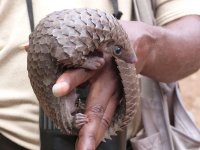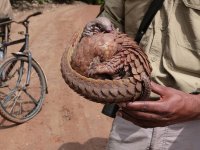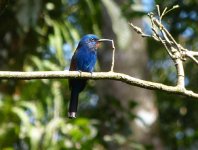
From 2 October (with a late arrival on the previous evening) to 17 October 2012, I was on a private 4-participants tour arranged by my brother and organized by Ashanti African Tours http://www.ashantiafricantours.com/index.php/our-tours/biriding-and-nature/. I can only express my greatest praise for the organizers, it was simply fantastic what we got to see. And considering the local infrastructure, they did everything to make us as comfortable as at all possible.
We had tried to do our "homework" as well in preparing for the trip. One major welcome feature was the fact that one of our tour members (Paul Roth) was able to work on the species list received from Ashanti African Tours. That list had a completely different species sequence than the one used for the Birds of Ghana FG. Thus, it was most welcome that Paul was able to adapt the list to follow the book, adding the plate pages as well. Hopefully, this list, corrected for some minor printing errors which we did not find time to eliminate, will now be used in the future.
The main itinerary followed the one found at the Sunbirdtours website http://www.sunbirdtours.co.uk/GhanaGoldcoasttothenorth.htm. In fact, we had the same organization and the same main guide Robert Ntakor. I will thus not repeat the route in details as far as it followed the same paths. We did however, add an extension to visit the area north of Mole NP, with the main - but not only - purpose of getting to see the Egyptian Plover. I'll just list a few highlights or peculiarities later on.
Basically, it was still rather moist, with often a covered sky. This helped to keep the heat down. The delayed rainy season did not affect us much, however. Except that the northern savannah vegetation was still very green. The species coming in from the north such as Four-banded Sandgrouse were thus mostly not there yet, or they were not visible. It must be noted, however, that one never gets to see all the birds listed anyway. Just look at the Sunbirdstours list for the last 4 trips http://www.sunbirdtours.co.uk/documents/Webpage-Ghana.pdf. Only the ones with a 4 in front were seen on all four trips. We missed some of those, such as Wahlberg's Eagle. But we also had a fair number not seen on any of those trips, such as Red-chested Swallow and Black-bellied Seedcracker, to just mention two that were not part of our northern extension. We ended up with a group total of 388 seen species, my personal tally was 374, with 256 life bids!
Most Eurasian migrants were not there yet which did not matter much to us. Rather than going for a 400+ species list, we wanted to concentrate our attention on the local species anyway. Our main guide Robert Ntakor and his assistant Paul Mensah made every effort to assure we got to see as many of those hard to get forest species as possible. Their phenomenal knowledge of the sounds helped tremendously to focus our attention on the "right" individual birds. And it was only thanks to their unrelenting efforts that I did not fall much behind the best spotters in our group. Robert was also very good in remembering who had not seen a particular species yet on revious days.
Due to the size of the country and the road conditions it takes considerable time to get from one good location to the next. There are only two major roads, one leading north from Accra to Burkina Faso via Kumasi, the second largest city. The other road going east - west near the coast. Even those roads often have dangerous potholes, and all the other roads are often such that only slow driving allows a certain comfort. Our Ashanti African Tours driver Eric Arthur, named Kojo did an excellent job. We came to appreciate his skills even more after we had taken a hair raising taxi ride which was necessitated for logistical reasons.
The few decent hotels available, often made for long drives to and from the observation sites. Thus, despite the tropical "12-hour" nights, sleep became a rarity right from the beginning. We never had more than 6 hours of sleep, sometimes only a bit more than 4 hours. Plus some dozing on the way for those that managed to catch it despite the many bumps.
Traffic around Accra (the capital) and Kumasi is terribly time consuming. At one time, it took us a full two hours to get from our hotel out of Kumasi. But for once, I think this was the most fascinating two hours I ever spent in a traffic jam. Africa can be exciting for other reasons than birds. And I very much loved this insight into the very different culture.
We had tried to do our "homework" as well in preparing for the trip. One major welcome feature was the fact that one of our tour members (Paul Roth) was able to work on the species list received from Ashanti African Tours. That list had a completely different species sequence than the one used for the Birds of Ghana FG. Thus, it was most welcome that Paul was able to adapt the list to follow the book, adding the plate pages as well. Hopefully, this list, corrected for some minor printing errors which we did not find time to eliminate, will now be used in the future.
The main itinerary followed the one found at the Sunbirdtours website http://www.sunbirdtours.co.uk/GhanaGoldcoasttothenorth.htm. In fact, we had the same organization and the same main guide Robert Ntakor. I will thus not repeat the route in details as far as it followed the same paths. We did however, add an extension to visit the area north of Mole NP, with the main - but not only - purpose of getting to see the Egyptian Plover. I'll just list a few highlights or peculiarities later on.
Basically, it was still rather moist, with often a covered sky. This helped to keep the heat down. The delayed rainy season did not affect us much, however. Except that the northern savannah vegetation was still very green. The species coming in from the north such as Four-banded Sandgrouse were thus mostly not there yet, or they were not visible. It must be noted, however, that one never gets to see all the birds listed anyway. Just look at the Sunbirdstours list for the last 4 trips http://www.sunbirdtours.co.uk/documents/Webpage-Ghana.pdf. Only the ones with a 4 in front were seen on all four trips. We missed some of those, such as Wahlberg's Eagle. But we also had a fair number not seen on any of those trips, such as Red-chested Swallow and Black-bellied Seedcracker, to just mention two that were not part of our northern extension. We ended up with a group total of 388 seen species, my personal tally was 374, with 256 life bids!
Most Eurasian migrants were not there yet which did not matter much to us. Rather than going for a 400+ species list, we wanted to concentrate our attention on the local species anyway. Our main guide Robert Ntakor and his assistant Paul Mensah made every effort to assure we got to see as many of those hard to get forest species as possible. Their phenomenal knowledge of the sounds helped tremendously to focus our attention on the "right" individual birds. And it was only thanks to their unrelenting efforts that I did not fall much behind the best spotters in our group. Robert was also very good in remembering who had not seen a particular species yet on revious days.
Due to the size of the country and the road conditions it takes considerable time to get from one good location to the next. There are only two major roads, one leading north from Accra to Burkina Faso via Kumasi, the second largest city. The other road going east - west near the coast. Even those roads often have dangerous potholes, and all the other roads are often such that only slow driving allows a certain comfort. Our Ashanti African Tours driver Eric Arthur, named Kojo did an excellent job. We came to appreciate his skills even more after we had taken a hair raising taxi ride which was necessitated for logistical reasons.
The few decent hotels available, often made for long drives to and from the observation sites. Thus, despite the tropical "12-hour" nights, sleep became a rarity right from the beginning. We never had more than 6 hours of sleep, sometimes only a bit more than 4 hours. Plus some dozing on the way for those that managed to catch it despite the many bumps.
Traffic around Accra (the capital) and Kumasi is terribly time consuming. At one time, it took us a full two hours to get from our hotel out of Kumasi. But for once, I think this was the most fascinating two hours I ever spent in a traffic jam. Africa can be exciting for other reasons than birds. And I very much loved this insight into the very different culture.
Last edited:







